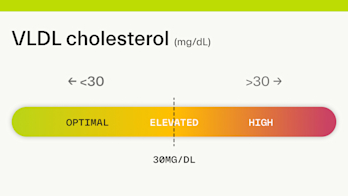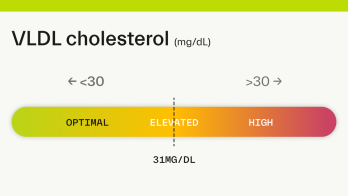VLDL Cholesterol: 30 mg/dL

What does a level of 30 mean? Are there any symptoms associated with this level?
A level of 30 mg/dL is considered elevated. Although cholesterol serves several important functions, elevated VLDL cholesterol may put you at greater risk for heart disease.
Elevated VLDL cholesterol doesn’t have symptoms, which is why it’s important to know your levels. Lowering them will decrease your risk of developing heart disease and other health issues.
If you already have heart disease, lowering your cholesterol can reduce your odds of serious complications, like a heart attack or stroke.
Learn more about what VLDL is recommended range
Factors that could contribute to a level of 30
Diet: Diets that are high in saturated fats, trans fats, added sugar, and low in fiber can lead to elevated VLDL levels.
Weight: Having excess fat, particularly around the abdomen, can also increase VLDL.
Physical activity: Being active can help lower VLDL levels by lowering your triglycerides. Learn more about triglycerides and what your levels mean
here
.Medications: Certain medicines can raise your VLDL levels secondary to your triglyceride levels. These include corticosteroids, beta-blockers, thiazide diuretics, antivirals, and estrogen.
Some medical conditions: Diseases involving the thyroid, liver, or kidney, as well as poorly controlled type 2 diabetes, can change triglyceride and VLDL levels.
Age and sex: Cholesterol levels tend to increase with age in both women and men. Premenopausal women tend to have lower
total cholesterol levels
than men of the same age. However, after the age of menopause, women's VLDL and LDL (bad) cholesterol levels tend to rise.Genetics (heredity): High blood cholesterol can run in families. This is because your genes partly determine how much cholesterol your body makes.
Smoking. Smoking lowers your HDL (good) cholesterol, which can contribute to a higher level of VLDL (bad) cholesterol. Learn what your HDL levels mean
here
.Excessive alcohol consumption:
Heavy drinking
can indirectly increase VLDL levels by raising triglyceride levels.
What to do if your level is 30?
The best way to lower VLDL is to reduce your triglycerides [ 1
Exercising for 30-60 minutes 5x/week.
Losing weight if you are overweight or obese.
Avoiding refined carbohydrates and limiting added sugars to less than <25 g/day.
Limiting your consumption of alcohol to <1-2 drinks/day.
Eating healthier fats like those found in nuts, seeds, avocados, olive oil, and salmon.
Avoiding trans fats and limiting saturated fat to <10% of total calories.
Quitting smoking.
Medications and supplements used to improve results
If diet and lifestyle changes do not lower triglyceride and VLDL levels enough on their own, some medications and supplements may help.
Medications
Prescription niacin: Niacin is a B vitamin that, when taken at prescription doses, can lower VLDL levels by reducing its production in the liver and improving HDL cholesterol levels [
2
].Fibrates: Help lower high triglyceride levels and may also help raise HDL cholesterol.
Statins: Statins (including atorvastatin, simvastatin, and rosuvastatin) may be prescribed if your LDL and total cholesterol levels are also elevated. Statins reduce cholesterol production in your liver and can effectively reduce VLDL levels [
3
]. Statins are only prescribed if diet and lifestyle changes aren’t enough [4
].
Supplements
Fish oil: The
omega-3 fatty acids in fish oil
can help lower your triglycerides and VLDL. Prescription fish oil contains more active fatty acids than many nonprescription supplements but can interfere with blood clotting, so check with a doctor before taking a high-dose supplement.
If you want to lower your cholesterol but don’t know where to start, you may want to give Elo Health a try. Elo provides curated nutrition recommendations based on your biomarker scores to create personalized supplements that fit your needs. You also get 1:1 dietitian coaching to further help you reach your health goals. Learn more about how we can help lower your cholesterol and optimize your nutrition here
References
VLDL cholesterol: Is it harmful? (2022, June 17). Mayo Clinic. Retrieved October 3, 2022, from
https://www.mayoclinic.org/diseases-conditions/high-blood-cholesterol/expert-answers/vldl-cholesterol/faq-20058275
McKenney J. (2004). New perspectives on the use of niacin in the treatment of lipid disorders. Archives of internal medicine, 164(7), 697–705.
https://doi.org/10.1001/archinte.164.7.697
Ginsberg H. N. (1998). Effects of statins on triglyceride metabolism. The American journal of cardiology, 81(4A), 32B–35B.
https://doi.org/10.1016/s0002-9149(98)00035-6
Carotid Artery Disease. (n.d.). National Heart, Lung, and Blood Institute | NIH. Retrieved September 9, 2021, from
https://www.nhlbi.nih.gov/health-topics/carotid-artery-disease


